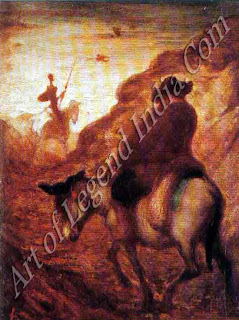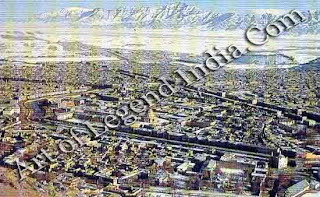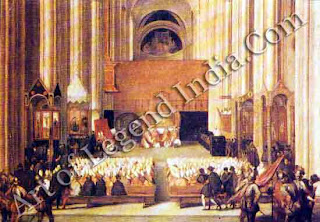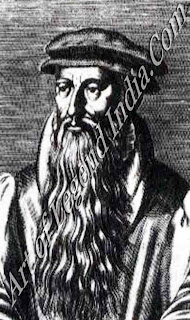A Year in the Life 1547
 In 1547
The Emperor Charles V won his great victory at Muhlberg over the Schmalkaldic
League of Protestant Princes with serious consequences for the Elector of
Saxony and his court painter Lucas Cranach. But the Protestant cause in Germany
and in Scotland during this year was only in temporary eclipse.
In 1547
The Emperor Charles V won his great victory at Muhlberg over the Schmalkaldic
League of Protestant Princes with serious consequences for the Elector of
Saxony and his court painter Lucas Cranach. But the Protestant cause in Germany
and in Scotland during this year was only in temporary eclipse.
Henry VIII
of England and Francis I of France were two of the three great princes who
dominated the European political scene during the first half of the 16th
century. Both died in the early months of 1547. The third prince, the Emperor
Charles V was to survive for another war-torn decade complicated by the
political repercussions of the Reformation.
Charles
V was absolute ruler of a huge empire 'on which the sun never set'. His
dominions ranged from Aztec Mexico in the West, conquered for him by Hernando
Cortes (who also died during 1547) to Austria in the East under his brother
Ferdinand. This vast dominion which even extended down into the Italian
peninsula, had seriously alarmed the French King who had taken the
unprecedented, and to some eyes the even heretical step of allying himself with
the Turks in the East. Although Pope Paul III had of necessity made an alliance
with the Emperor, their relationship by 1547 was less than amicable.

Two
years earlier the Pope had convened the Council of Trent which, dominated by
the newly founded Society of Jesus, was to become the spearhead of the Counter
Reformation. Meeting at Trent in northern Italy (modern Trentino) on Imperial
soil, Protestant and Catholic representatives were invited from all over
Christendom. The Pope was attempting to establish peaceful relations within
Europe so as to present a united front against the Turks.
While
Paul III saw the council as of doctrinal importance, Charles on the other hand
had hoped it would be an excellent forum for sorting out the unification of
Protestant and Catholic Germany. He was obsessed with establishing imperial
supremacy over his German princedoms. Inevitably there were clashes between
papal and imperial policies with the result that the council was moved from Trent
to Bologna on papal authority in March 1547 to the fury of the Emperor. There
could be no hope of settling German religious problems on papal territory with
a papal Council. An impasse was reached until the election of a new pope.
PROTESTANT DEFEATS
 Charles
now concentrated on suppressing the Schmalkaldic League of Protestant
Princedoms which threatened his supremacy. He declared war on the League and
succeeded in shattering it at the Battle of Muhlberg in April 1547. The capture
of the Elector John Frederick and his being forced to sign the capitulation of
Wittenberg, the very heartland of Protestantism, was a blow from which Saxony
never recovered. Cranach left Wittenberg to join his master in confinement at
Augsburg. Nevertheless, no doubt to the artist's satisfaction, the Emperor's
success was to be very shortlived.
Charles
now concentrated on suppressing the Schmalkaldic League of Protestant
Princedoms which threatened his supremacy. He declared war on the League and
succeeded in shattering it at the Battle of Muhlberg in April 1547. The capture
of the Elector John Frederick and his being forced to sign the capitulation of
Wittenberg, the very heartland of Protestantism, was a blow from which Saxony
never recovered. Cranach left Wittenberg to join his master in confinement at
Augsburg. Nevertheless, no doubt to the artist's satisfaction, the Emperor's
success was to be very shortlived.
Religion
also played a large part in English politics during this year. Henry VIII died
in January, leaving the throne to his nine-year-old son Edward. His uncle
Edward Seymour (brother of Jane Seymour, Henry's fourth wife) assumed the
position of Lord Protector. He pursued Henry's policy of trying to bully the
Scots into a Protestant union through alliance by marriage to the young Edward
VI. James V of Scotland had died five years previously leaving a week-old
daughter from his marriage to the French aristocrat Mary of Guise. This infant
was none other than the ill-fated Mary Queen of Scots.
Terrified
of the continuation of the 'auld alliance' between Scotland and France, the
English resorted to what was described as the 'Rough Wooing' hoping to win the
young Scottish Queen by force. An able general, the Lord Protector defeated the
Scots at the battle of Pinkie in September but was too late t save the Scots
Protestants who were holding out in St Andrews Castle. French guns battered the
castle into submission and the occupants, including the reformer John Knox,
were carried off into slavery in French galleys. The worst blow was the capture
of the young Queen who was promptly married the following year to the dauphin
of France. Once more the wily Scots were a thorn in the side of the English.
Writer
– Marshall Cavendish
 In 1547
The Emperor Charles V won his great victory at Muhlberg over the Schmalkaldic
League of Protestant Princes with serious consequences for the Elector of
Saxony and his court painter Lucas Cranach. But the Protestant cause in Germany
and in Scotland during this year was only in temporary eclipse.
In 1547
The Emperor Charles V won his great victory at Muhlberg over the Schmalkaldic
League of Protestant Princes with serious consequences for the Elector of
Saxony and his court painter Lucas Cranach. But the Protestant cause in Germany
and in Scotland during this year was only in temporary eclipse.  Charles
now concentrated on suppressing the Schmalkaldic League of Protestant
Princedoms which threatened his supremacy. He declared war on the League and
succeeded in shattering it at the Battle of Muhlberg in April 1547. The capture
of the Elector John Frederick and his being forced to sign the capitulation of
Wittenberg, the very heartland of Protestantism, was a blow from which Saxony
never recovered. Cranach left Wittenberg to join his master in confinement at
Augsburg. Nevertheless, no doubt to the artist's satisfaction, the Emperor's
success was to be very shortlived.
Charles
now concentrated on suppressing the Schmalkaldic League of Protestant
Princedoms which threatened his supremacy. He declared war on the League and
succeeded in shattering it at the Battle of Muhlberg in April 1547. The capture
of the Elector John Frederick and his being forced to sign the capitulation of
Wittenberg, the very heartland of Protestantism, was a blow from which Saxony
never recovered. Cranach left Wittenberg to join his master in confinement at
Augsburg. Nevertheless, no doubt to the artist's satisfaction, the Emperor's
success was to be very shortlived. 












0 Response to "German Great Artist Lucas Cranach - A Year in the Life 1547"
Post a Comment